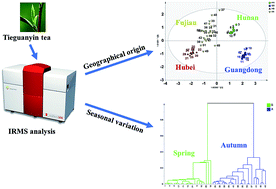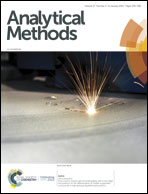A multi-element stable isotope approach coupled with chemometrics for the determination of Tieguanyin tea geographical origin and harvest season
Abstract
The taste and aroma quality and the price of tea are largely impacted by the geographical origin and harvest season. Tieguanyin teas differing in sites of growth and harvest season were characterized by the analysis of stable isotopes of nitrogen, carbon, hydrogen and oxygen (δ15N, δ13C, δD and δ18O). The δ15N, δ13C, δD and δ18O values were determined by elemental analyzer-isotope ratio mass spectrometry (EA-IRMS). All δ15N, δ13C, δD and δ18O values exhibited significant differences (p < 0.05) in the samples of different regional origins, whereas the δD and δ18O values highly differed (p < 0.01) between spring and autumn Tieguanyin teas. With the aid of chemometrics, orthogonal projection to latent structures discriminate analysis (OPLS-DA) achieved 96.08% recognition rate for Tieguanyin teas from different regions, whereas stepwise linear discriminant analysis (SLDA) allowed 100% differentiation. Moreover, principal component analysis (PCA) and hierarchical cluster analysis (HCA) methods revealed excellent discrimination possibilities for the teas according to seasonal variations. Additionally, our study presented a good alternative to differentiate teas from different sites of growth and harvest seasons and also to address the quality control and food authenticity concerns.



 Please wait while we load your content...
Please wait while we load your content...